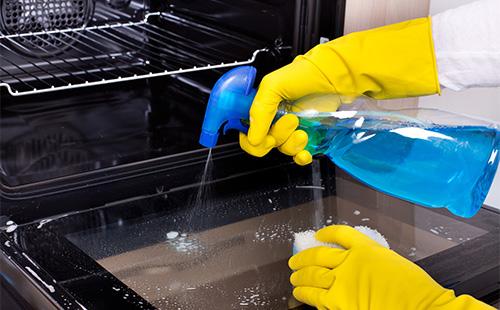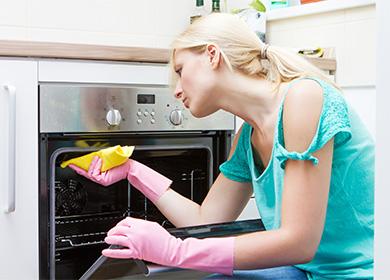The content of the article
Powder and a stiff metal sponge - these are the weapons most housewives use to fight grease on the inside walls of the oven. But hard particles mercilessly scratch the surface without completely removing dirt. But the steam acts gently, gradually dissolving the oily coating. That is why manufacturers of kitchen appliances are increasingly introducing a steam cleaning system into appliances.
Hydrolysis cleaning of the oven: what is it
Hydrolysis cleaning of the oven is the cleaning of surfaces with steam. Under the influence of water in a gaseous state of aggregation, fat, soot and other impurities that accumulate on the surface dissolve. Many modern ovens have this feature integrated. But this is not a new technical invention. Rather, manufacturers of household appliances adopted the many years of experience of housewives. The principle of hydrolysis cleaning the oven can be described in six consecutive steps.
- Water is poured into a deep pan. If the oven provides a hydrolysis system, then special notches are provided for the liquid.
- Cleaning products are added to the water.
- At what temperature hydrolysis is carried out, it is determined by the type of coating. Usually, it is 50-90 ° C. In devices with the factory function of steam cleaning, the temperature is set automatically.
- About half an hour after the device starts to work, steam begins to be released, which, settling on the walls, dissolves fat.
- After turning off the device, you need to give it five to ten minutes to cool, and then wipe the surface with a sponge with detergents.
- If not all contaminants could be cleaned the first time, the hydrolysis procedure is repeated.
Advantages and disadvantages
If you are tired of wiping your oven from burnt fat, it is worth experimenting with steam. Reviews of the hydrolysis cleaning of the oven allow us to highlight a number of advantages and disadvantages.
Table - Advantages and disadvantages of hydrolysis treatment
| Benefits | disadvantages |
|---|---|
| - The relatively low cost of devices with such a cleaning system; - hydrolysis is applicable to old models of household appliances; - the low processing temperature does not adversely affect the oven itself and the appliances standing nearby; - suitable for both gas and electric devices; - low power consumption; - steam does not damage the enamel | - Does not provide complete cleaning; - requires additional processing; - hydrolysis can not cope with stubborn stains; - it is necessary to free the oven from pans and wire racks; - before starting work, you need to wait for the oven to cool completely after the last cooking |
If the function is not integrated ...
If the oven is equipped with an automatic cleaning function, as a rule, it is accompanied by detailed instructions on how to make hydrolysis cleaning of the oven, as well as recommendations on detergents. If the device does not provide such an option, at home you can use four effective means.
Vinegar
- In two glasses of water, dilute half a glass of table vinegar.
- Place a container of water in the oven.
- When the temperature reaches 90 ° C, continue heating for another half hour.
- Wipe the walls with a sponge.
Lemon
- Pour two glasses of water and a couple tablespoons of dishwashing liquid onto the baking sheet.
- Slice the lemon into slices and also place on a baking sheet.
- Insert the container into the oven and preheat to 150 ° C.
- After half an hour, turn it off, let it cool slightly.
- Wipe off any dirt.
Laundry soap
- Grate half a bar of laundry soap and dissolve in a liter of warm water.
- Put the container with the solution in the oven and heat to 150 ° C.
- After 45 minutes, unplug.
- Rub the walls with the hard side of the kitchen sponge and wash with clean water.
- Leave the oven door open for eight hours to ventilate.
Salt
- Pour two glasses of water into a refractory container and dissolve 300 g of salt in it.
- Place the pan in the bottom of the oven and warm to 200 ° C.
- After half an hour, turn off the stove.
- Wash the still warm walls with a detergent sponge.
Overview of other modern systems
Modern housewives value their time and want to spend it on themselves and loved ones, and not on endless cleaning. This is what inspires home appliance manufacturers to introduce advanced oven cleaning systems.
Catalytic
Catalytic purification is carried out due to a special porous coating, which contains copper, cobalt, cerium dioxide and manganese in its composition. The principle of operation consists of three main stages.
- Process start. When the oven is heated to 140 ° C, the oven will automatically start cleaning.
- Chemical reaction. When heated to 200 ° C, a chemical reaction begins during which the fat breaks down into water and soot.
- Removing residual contaminants. Having completed the cooking process, it remains to wait for the oven to cool and wipe the surface from contamination.
To understand which is better - hydrolysis or catalytic cleaning of the oven, it is worth considering the advantages and disadvantages of the latter, described in the table.
Table - Advantages and disadvantages of catalytic purification
| Benefits | disadvantages |
|---|---|
| - Save time (the cleaning process is during operation); - no preliminary preparation is required; - the system is applicable to both gas and electric devices; - low energy consumption (no more than cooking) | - High price - catalytic panels eventually lose their properties and require replacement (every three to five years); - the bottom and doors of the oven do not have a catalytic coating, and therefore they will have to be cleaned manually or by hydrolysis; - fat breakdown products must be removed manually |

Pyrolytic
Today, the most effective and at the same time the most expensive system is pyrolysis. What is the difference between hydrolysis treatment and pyrolytic treatment? The fact that in the first case the fat only softens, and in the second it burns out under the influence of high temperature (up to 500 ° C). The hostess can only sweep away the ash formed from the walls and the bottom of the oven.The pros and cons of pyrolysis are analyzed in more detail in the table.
Table - Advantages and disadvantages of pyrolytic treatment
| Benefits | disadvantages |
|---|---|
| - For the duration of the program, the oven is blocked to ensure safety; - full cleaning that does not require additional wet processing; - there is no need to get trays and grids (if they are fireproof) before starting the system; - extends the life of the kitchen appliance | - High price; - applies only to electrical appliances; - increased power consumption when heated to 500 ° C; - the presence of a burning smell during system operation; - due to the strong heating of the oven, household appliances and furniture located next to it may deteriorate; - the oven must be equipped with a durable cable that can withstand high voltage |
What is right for you?
Modern technology allows housewives to keep kitchen appliances in perfect cleanliness. But are the costs for the purchase and installation of expensive equipment with a particular cleaning system justified? It all depends on the frequency and purpose of using the oven:
- hydrolysis - suitable for rare use of the oven (not more than once a week);
- catalytic - with frequent preparation of meat and fish dishes with fatty sauces;
- pyrolytic - with the frequent preparation of all kinds of baking, cottage cheese casseroles and confectionery.
Hydrolysis is an ideal way to clean the oven with water. Even if the kitchen “assistant” is not equipped with an automatic cleaning system, you can easily clean it with ordinary steam. And so that the need for such cleaning occurs as rarely as possible, protect the surfaces of the oven from grease. This is possible by using special covers, foil and sleeves for baking.

